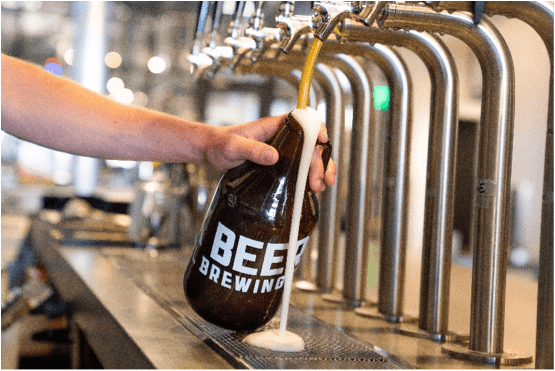The Role of The Tunnel Pasteurizer: How Safe is Safe?
Creating and producing beverages are important to our lives and our livelihoods. As professionals, we are vigilant about food safety risks and taking very possible step to reduce as much as possible, conditions which create opportunity for problems.
The microbiological status of a packaged beer, especially one destined for a distant market, is of prime concern and a brief Google browse shares, “the only satisfactory microbiological test is to pass at least 100 ml of beer through a 0.45 micrometer membrane, then plate the membrane on media (such as MRS or other media to be detailed) under conditions (for instance anaerobic at about 25° C) capable of detecting the target organisms in low number”.
As much as we would wish, a study of a beer samples under a microscope doesn’t work. Release of beer to the trade should await evaluation of its microbiological status, and it is possible, after sufficient time, to release products prior to having microbiological results, after ample opportunity to determine how ‘clean’ the tunnel pasteurized beer/beverage is. Some situations dictate that the packaged product is always held until complete micro release. The essential requirement of evaluation of efficacy is to carefully study a package of beer before it is pasteurized and after a package of the same beer batch has been pasteurized. Organisms are exposed to heat and the numbers surviving before and after treatment are determined. Viability is judged from the ability to multiply (to produce microcolonies).
Hsu’s Lactobacillus and Pediococcus (HLP) media can be employed to screen for common beer spoilers, while selecting against other organisms, such as yeast, gram negative bacteria and aerobic microbes (1). Other media include Lee’s multi-differential agar, Raka-Ray lactic acid bacteria medium, lysine medium, Lin’s wild yeast differential medium, Barney-Miller brewery medium, De Man Rogosa Sharpe medium, MYGP + copper medium, CLEN medium for wild yeast. The respected DIFCO Manual lists brewery-specific microbiological media (and their composition) including: Orange Serum Agar, UBA (Universal Beer Agar), Wort Ager, WL Nutrient Medium (Wallerstein Labs), WL Nutrient Broth, WL Differential Medium, YM Agar (Yeast Malt Extract), YM Broth. There are reported advantages to using various plating media.
For example, UBA supports growth of more varieties of lactic acid bacteria and yields larger quantities of these colonies in a shorter time, and it is a selective medium because within it, there is beer. Growth of microorganisms that have adapted themselves to thrive in breweries are detected. The presence of hop constituents and alcohol eliminates the growth of many airborne pathogens. UBA supports growth of lactobacilli, pediococci, acetobacter and yeast strains robustly. Actidione at a level of 1 microgram per ml (1 ppm) is incorporated when samples containing yeast are cultured.
Temperatures to denature organisms and spoilage patterns
Industrial microbiologists have characterized the optimal temperatures for many species, i.e. brewing yeast 55 deg C;Moulds 65-80 deg C depending on species; Clostridium species (incl botulininum) 82-100 deg C depending on species.
The spoilage patterns of beer and ale can be classified into four groups: ropiness, sarcinae, sourness and turbidity. Ropiness can be caused by Acetobater, Lactobacillus, Pediococcus cerevisiae and Gloconobacter oxydans (formerly Acetomonas). Sourness arises from Acetobacter spp. (which oxidize ethanol to acetic acid). Turbidity (and off-odors) in beer may be caused by Zymomonas anaerobia and several yeasts such as Saccharomyces spp. In 1978, Coors Golden isolated Pectinatus cerevissphilius, which was then reported in other countries. Sarcinae is caused by P. cerevisiae, which will manifest a honey aroma and diacetyl flavor.
Packaged beer is susceptible to Saccharamoyces diastaticus,
which can utilize dextrins in the beer which normal brewer’s yeast could not
metabolize.

When this author worked in helping determine global tunnel pasteurization standards for one international brewing group, it was decided that the rate of under-pasteurized packages could not be less than one per 10,000 packages…which was the standard maximum-acceptable leaker rate at the time for the little milk boxes by Tetra-Pak used for school lunches (an interesting and completely unrelated comparator).
Using the Crystal Ball Monte Carlo add-on to MS Excel, it required a pasteurization target of 21 Pasteurization Units (PUs) to assure that the no more than 1 per 10,000 packages could be assured…when the real target was 15 PUs. This is the scrutiny that packages shipping all over the world require.
Yet it’s a different level of assurance required for beverages staying within a country and within a ‘normal’ shelf life. The simple question of “how safe is safe?’ relies on honest evaluation of what are valid criteria and the life of the packaged beverage after it leaves the brewery or beverage plant finished goods warehouse.
PRO Engineering can refer clients to specialized, certified, microbiological testing labs to help determine appropriate pasteurization levels, and a PRO pasteurizer can be configured to offer different pasteurization regimes. A fully-fermented alcoholic spritzer with flavors and no added sugar may require lower pasteurization than a barrel-aged beer. This author was fortunately in a large brewery setting with voluntary microbiological testing of pre- and post-pasteurized samples, when it was determined that 8 PU was a good target for a PRO tunnel pasteurizer. As mentioned, expert labs are available for confidential reporting and validation of acceptable post-pasteurization packaged beer and beverages.
What is desired is ‘non-detectable’ or “less than 1” CFU/ml for aerobic bacterial testing, anaerobic bacterial testing, and yeasts and molds.
Tunnel pasteurization is a great means to achieve log-reductions of organisms that we don’t want in our beverages, a last defense bestowed on the beverages before they leave the facility. However, GMP and excellent cleaning and sanitation of all processes and unit operations (in bulk, in transport, and in packaging) prior to pasteurization are mission-critical to any ‘belt & braces’ approach to beverage quality assurance. The same goes for establishing an in-house microbiological testing lab. Regular and rigorous validation of microbiological status of packaged product for each batch is an expectation borne from prudence and the commitment to beverage quality assurance.
Authored by Jaime Jurado
Past President-MBAA
(Master Brewers Association of the Americas)
https://www.linkedin.com/in/jaimejurado/
https://independent.academia.edu/JaimeJurado
Sponsored by Ed Michalski, CEO PRO Engineering and Manufacturing, Inc
PRO and Manufacturing, Inc has been providing equipment and engineering services to the beverage industry for 42 years. Contact Ed Michalski, CEO at: (414) 362-1500, [email protected]

ABOUT US:
PRO Engineering and Manufacturing was established in 1977 by Ed and Dave Michalski as a steel fabrication shop. For more than 40 years, PRO Engineering and Manufacturing, Inc. has been delivering solutions for beverage product shelf stability and consumption safety. As leading innovators in post-fill pasteurization, our skilled team offers the best in high-quality pasteurization equipment.
CONTACT US:
Phone: 414-362-1500 | Email: [email protected]

